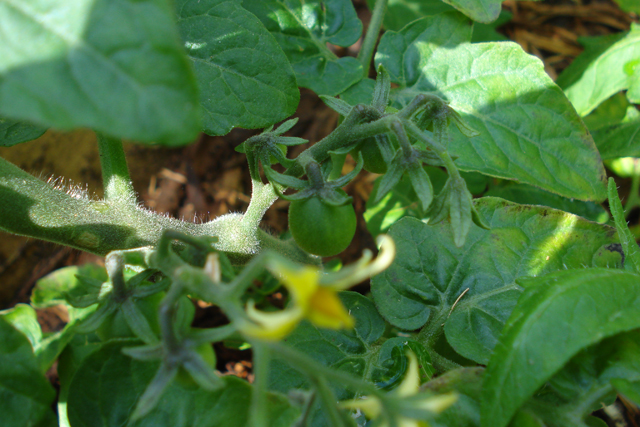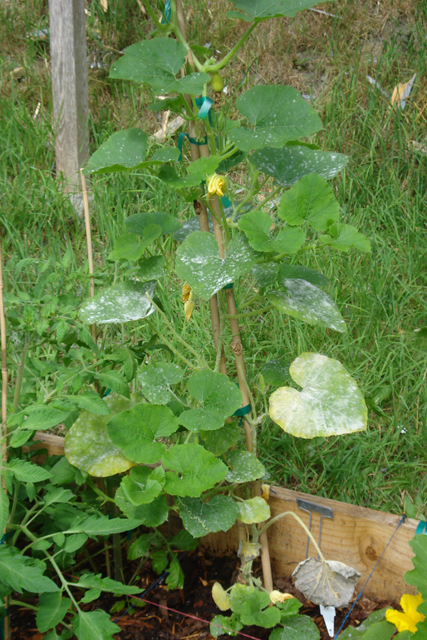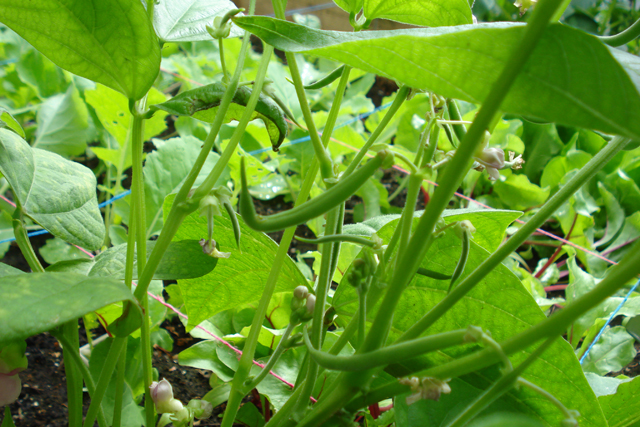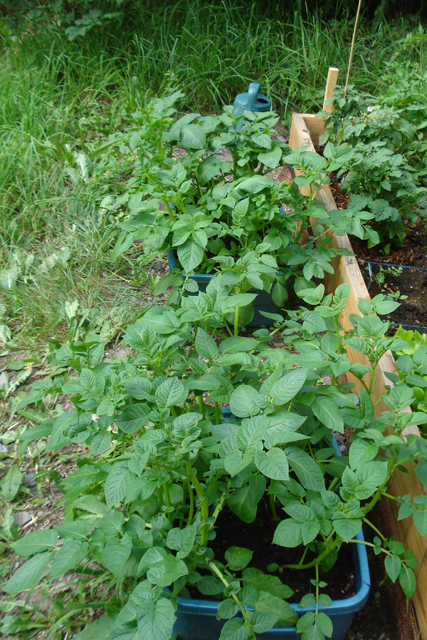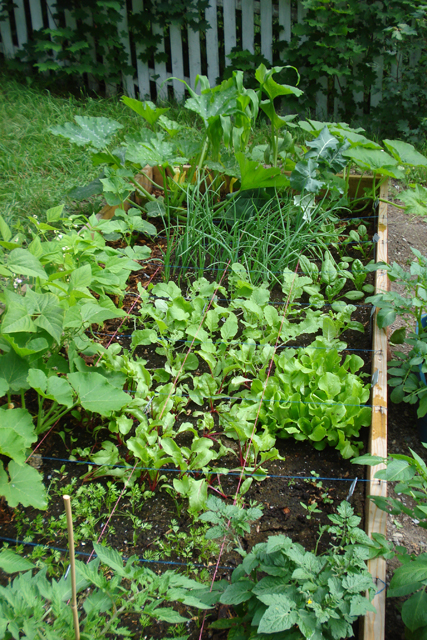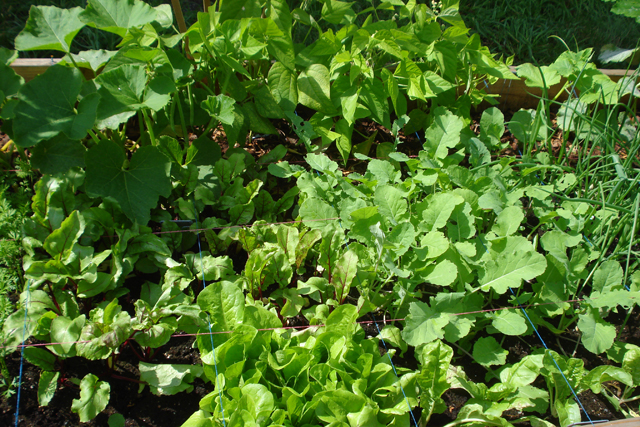Hi folks - Rick here,
I have now had several delicious salads from the garden: lettuce, beet and turnip tops (while thinning out the small ones), some green beans and squash flowers (you can eat them). There have been a few issues to talk about, though.
Water Ban!
I'm sure every gardener using the city water supply has been affected by the water ban. You're not supposed to do any watering of any vegetable or flower garden. An exception is made for water from a rain barrel or 'grey water', used cleaning water from the house. We save grey water from the shower in a couple of buckets, so I've been doing a little watering. There's a rain barrel construction workshop happening at the St. John's Farmer's Market this Saturday, August 8, at 12:30 PM. Actually, the Northeast Avalon ACAP Green Team, who are giving the workshop, will be there all day (from 9-2) if you're interested.
Pollination
Eek! My various summer squash plants (zucchini, spaghetti, mystery) had not been producing any squash. There were plenty of flowers, and a few tiny fruit which would shrivel up and fall off. I don't know anything about plant biology, but I'm starting to think I should read up. As it turns out, squash plants each produce male and female flowers. The male flowers are on long stems, and the female flowers are on shorter stems with tiny fruit behind them. In order for the fruit to mature, pollen has to get from the male flower to the female flower. Normally bees and other insects will transfer the pollen, but sometimes you need to do it yourself. It seems there aren't that many bees around my garden, because it hasn't been happening on its own, yet (you can plant certain flowers to attract bees). Since learning that I would need to pollinate the flowers myself, I've done a few, and I think I now have some zucchinis growing!
I googled it and, according to some websites' instructions, I would break off a male flower which had just opened, peel away the petals, and "nuzzle the anthers onto the stigma of a female flower, leaving a dose of pollen behind." I can't seem to show up at the garden (I don't live at the house) at a time when the female flowers are open, so I've been damaging the flowers' petals a bit while opening them, but I think that's OK. You can use one male flower to pollinate up to three female flowers, and they say to use a newly opened male flower. They seem to go moldy after a few days. Cool Fact: You can use the male flower of one type of squash plant to pollinate the female flower of any other variety of squash plant. The squash will turn out fine, but it's seeds will be of the cross-breed. So if you're saving seeds it's an issue (you'll get mystery squash?).
Tomato flowers have both male and female parts in the same flower, and just need a bit of wind to ensure spreading of the pollen or whatever inside the flower. Hence I have some tomatoes growing now without having done anything (except pruning!).
Plant Care
I have been pruning the tomato plants. I had been taught a few years ago to squeeze off the "suckers" that grow out of the corner between the main stem and a side leaf stem or flower stem. The stems that grow out of the corners become like new main stems which can grow more leaves and flowers. If you pinch them off the plant grows taller. More recently I've been reading about it, and it seems you should let a few of these stems grow out higher up on the plant to get more tomatoes. I think I have some more to learn about pruning tomato plants. I am thinking of cutting off the new growth entirely sometime very soon to encourage the plant to focus its energy on growing fruit.
I've also been staking up the tomatoes and a few other things, but I think my thin bamboo sticks are too light. Next year I'll have to try and have some bigger arch shaped supports.
Slugs
I've found two slugs in the garden so far, which is not bad at all. I suspect they may have climbed up the potatoes in the containers (not surrounded by copper) and then dropped into the delicious raised bed. I've moved the potatoes away to prevent that. I've also had the pumpkin plants growing out over the side of the bed onto the ground, which could allow the slugs to eat them and climb up to the bed. In an attempt at a quick solution we laid some copper out flat on the ground around the pumpkin plants, but I don't know how well that will work.
Plant Spacing
That pumpkin issue is really happening because I planted the squash too densely. The square foot gardening instructions say to give each plant 2 or more square feet. I was greedy and gave one square foot each. Some of the huge leaves are growing into my other plants and pushing them over or shading them. Maybe next year I should have a bed dedicated to squash plants... maybe a bit higher up so that they can fall over the sides.
I think I may have planted some of the greens too far apart. The Mesclun mix was planted with seeds everywhere, with no order. Subsequently I have a square that's thick with lettuce (it seems that the other seeds in the mix didn't work, being over a year old). The spinach and swiss chard are growing alright, but not into really big full plants that take up their space. I followed the directions: if spinach plants are supposed to go 6 inches apart, than there should be 4 of them in a square foot. I feel like if I had just sprinkled the seeds everywhere, I'd have loads of spinach. I'll give it a try later in the season.
That's all for now. I also have some white fungus or something growing on many of the squash plants (all from the same nursery). I've been meaning to try washing the plants, but haven't gotten around to it. They're doing alright, though losing a few leaves to the fungus. In some of the photos you may see the vertically growing squash plant with a lot of white on it.
I'm excited about some of the things I'll be getting out of the garden soon! And I'm already planning for next year...
-Rick


